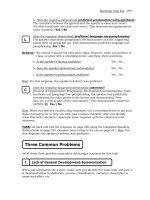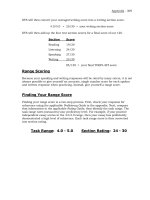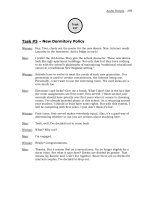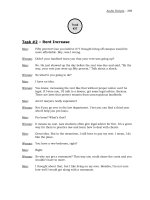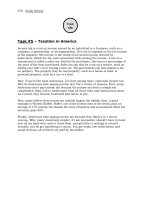Sign hibi cones and pieri algebras for the general linear groups
Bạn đang xem bản rút gọn của tài liệu. Xem và tải ngay bản đầy đủ của tài liệu tại đây (937.08 KB, 116 trang )
SIGN HIBI CONES AND PIERI ALGEBRAS
FOR THE GENERAL LINEAR GROUPS
WANG YI
(B.Sc., ECNU, China)
A THESIS SUBMITTED
FOR THE DEGREE OF DOCTOR OF PHILOSOPHY
DEPARTMENT OF MATHEMATICS
NATIONAL UNIVERSITY OF SINGAPORE
2013
To my parents
iv
v
Acknowledgements
First of all, I would like to thank my supervisor Professor Lee Soo Teck for his
guidance, encouragement and patience. What I have learnt from him is not only
mathematics but also the way of life and the attitude to research. I feel very proud
to be his student.
I would like to thank Professor Roger Howe and Professor Sangjib Kim for their
interest in my work. Conversations with them enrich my knowledge and clear my
doubts.
I would like to thank Ji Feng and Ma Jia Jun for many helpful discussions and
suggestions. I learn a lot from them.
I would like to thank Gao Rui, Li Xudong and Hou Likun for the two years happy
life when we live together.
I would like to thank Sun Xiang who helped me solving problems of L
A
T
E
X.
vii
viii Acknowledgements
I would like to thank Li Shangru and Yuan Zihong for memorable trips.
Lastly, I would like to thank my parents for their encouragement and support.
Contents
Acknowledgements vii
1 Introduction 1
2 Preliminaries 5
2.1 Representations of Linear Algebraic Groups . . . . . . . . . . . . . . 5
2.2 Rational Representations of GL
n
. . . . . . . . . . . . . . . . . . . . 8
2.3 Generalized Iterated Pieri Rules for GL
n
. . . . . . . . . . . . . . . . 12
2.3.1 Polynomial Iterated Pieri Rule . . . . . . . . . . . . . . . . . . 12
2.3.2 Generalized Iterated Pieri Rule . . . . . . . . . . . . . . . . . 15
2.4 Posets and Hibi Cones . . . . . . . . . . . . . . . . . . . . . . . . . . 21
2.4.1 Posets . . . . . . . . . . . . . . . . . . . . . . . . . . . . . . . 21
2.4.2 Increasing Subsets and Decreasing Subsets . . . . . . . . . . . 22
2.4.3 Hibi Cones . . . . . . . . . . . . . . . . . . . . . . . . . . . . . 23
2.4.4 The Hibi Cone Z
Γ
n,k,h
,
≥0
. . . . . . . . . . . . . . . . . . . . . . 26
2.5 Standard Monomial Theory for Hibi Algebras . . . . . . . . . . . . . 30
2.5.1 Standard Monomial Theory . . . . . . . . . . . . . . . . . . . 30
ix
x Contents
2.5.2 Semigroup Algebras . . . . . . . . . . . . . . . . . . . . . . . . 31
2.5.3 Semigroup Algebras on Hibi Cones . . . . . . . . . . . . . . . 31
2.6 (GL
n
, GL
k
) Duality . . . . . . . . . . . . . . . . . . . . . . . . . . . . 32
2.7 An Overview of Pieri Algebras . . . . . . . . . . . . . . . . . . . . . . 33
2.8 Polynomial Iterated Pieri Algebras . . . . . . . . . . . . . . . . . . . 35
2.8.1 The Construction of the Polynomial Iterated Pieri Algebras . 35
2.8.2 Polynomials Associated with Tableaux . . . . . . . . . . . . . 37
2.8.3 Monomial Ordering and Sagbi Basis . . . . . . . . . . . . . . . 39
2.8.4 The Structure of R
n,k,h
. . . . . . . . . . . . . . . . . . . . . . 42
2.8.5 Reciprocity Algebras . . . . . . . . . . . . . . . . . . . . . . . 44
2.8.6 General Iterated Pieri Algebras . . . . . . . . . . . . . . . . . 45
3 Sign Hibi Cone 49
3.1 The Structure of the Sign Hibi Cone . . . . . . . . . . . . . . . . . . 49
3.2 Subsemigroups of Sign Hibi Cone . . . . . . . . . . . . . . . . . . . . 53
3.3 The semigroup Ω
n,k,l
. . . . . . . . . . . . . . . . . . . . . . . . . . . 61
3.4 Further Results . . . . . . . . . . . . . . . . . . . . . . . . . . . . . . 67
3.4.1 Expression of Elements in a Sign Hibi Cone . . . . . . . . . . 67
3.4.2 Further Structure of Ω
A,B
. . . . . . . . . . . . . . . . . . . . 70
4 Anti-row Iterated Pieri Algebras 73
4.1 Construction . . . . . . . . . . . . . . . . . . . . . . . . . . . . . . . 73
4.2 Generators of A
n,k,l
. . . . . . . . . . . . . . . . . . . . . . . . . . . . 75
4.3 Leading Monomials . . . . . . . . . . . . . . . . . . . . . . . . . . . . 84
4.4 Structure of Anti-row Iterated Pieri Algebras . . . . . . . . . . . . . . 91
4.5 Applications to Howe Duality . . . . . . . . . . . . . . . . . . . . . . 93
4.6 Future Research . . . . . . . . . . . . . . . . . . . . . . . . . . . . . . 96
Contents xi
Bibliography 97
Chapter 1
Introduction
Let G be a complex classical group, and let U and V be finite dimensional irreducible
representations of G. Then the tensor product U ⊗ V is also a representation for
G, but it is not irreducible in general. It is an important problem to describe the
decomposition of U ⊗ V into a sum of irreducible representations of G.
In the case when G = GL
n
= GL
n
(C), the finite dimensional irreducible rational
representations of G are indexed by pairs (D, E) of Young diagrams such that the
sum of the depth of D and E is at most n (the depth of a Young diagram D is
the number of rows of D) ([Ho95]). We denote the representation corresponding to
(D, E) by ρ
D,E
n
, and write ρ
D,E
n
as ρ
D
n
when E is the empty diagram. There is a
combinatorial description of how a tensor product of the form ρ
D
n
⊗ ρ
E
n
decomposes.
It is called the The Littlewood-Richardson Rule ([LR],[Fu],[HL12]). In the
case when E = (α) has only one row with α boxes, the description of how ρ
D
n
⊗ ρ
(α)
n
decomposes is called the Pieri Rule ([GW], [Ho95]). Although the Pieri Rule is a
very special case of tensor product, it is of special interest because it is connected
with the branching rule from GL
n
to GL
n−1
([Ho95]). Thus it is a natural question
to consider a more general version of the Pieri Rule, that is, a description of how
1
2 Chapter 1. Introduction
tensor products of the form
ρ
D,E
n
⊗
h
s=1
ρ
(α
s
)
n
⊗
l
t=1
ρ
(β
t
)
∗
n
(1.1)
decomposes. Here the representation ρ
(β
t
)
∗
n
is dual to ρ
(β
t
)
n
.
In the paper [HKL], the authors constructed an algebra A
n,k,p,h,l
which encodes in-
formation on the decomposition of (1.1) with depth(D) ≤ k, depth(E) ≤ p and
depth(D) + depth(E) ≤ n. The algebra A
n,k,p,h,l
is called a ((k, p), h, l)-Pieri alge-
bra for GL
n
. There are some special cases. If p = l = 0, it is called a polynomial
iterated Pieri algebra. If p = h = 0, it is called an anti-row iterated Pieri
algebra (which will be studied in this thesis). There are also analogues of Pieri
algebras for O
n
= O
n
(C) and Sp
2n
= Sp
2n
(C), which are discussed in [KL].
In [HKL], the authors studied the structure of the algebra A
n,k,p,h,l
in the stable
range, that is, k+p+h+l ≤ n. In this case, the structure of the algebra is controlled
by a semigroup H, called a Hibi cone ([Ho05]). The semigroup H has a very nice
and simple structure: It has a finite set G of generators, and on which one can define
a partial ordering. Each nonzero element f of H has a unique standard expression
as a sum f =
u
i=1
g
i
where g
i
∈ G for 1 ≤ i ≤ u and g
1
g
2
· · · g
u
with
respect to the partial ordering in G. To each g in G, the authors define an element
v
g
in the algebra A
n,k,p,h,l
, and let S = {v
g
: g ∈ G}. Then the partial ordering on G
induces a partial ordering on S. A monomial on S of the form v
g
1
v
g
2
· · · v
g
u
is called
standard if v
g
1
≤ v
g
2
≤ . . . ≤ v
g
u
. The authors proved that the set of standard
monomials on S form a vector space basis for A
n,k,p,h,l
. Furthermore, A
n,k,p,h,l
has a
flat deformation to the semigroup algebra C[H] on H. Similar results for Sp
2n
and
O
n
are obtained in the paper [KL].
This thesis has two objectives. The first objective is to study the structure of a class
of semigroups which are more general than Hibi cones and are potentially useful in
3
representation theory. A Hibi cone is constructed from a finite poset Γ; it is the set
Z
Γ,
≥0
of all order preserving functions f : Γ → Z
≥0
with semigroup operation given
by the addition of functions. It is natural to consider order preserving functions on
Γ which are allowed to take negative values. Thus we consider the semigroup Z
Γ,
of all order preserving functions f : Γ → Z, and we call it a sign Hibi cone. More
generally, if A and B are two subsets of Γ, then we let
Ω
A,B
= {f ∈ Z
Γ,
: f(A) ≥ 0, f(B) ≤ 0}.
If A = Γ and B = ∅, then Ω
A,B
= Z
Γ,
≥0
. Thus Ω
A,B
is a more general construction
than a Hibi cone. We show that Ω
A,B
retains many nice properties of a Hibi cone. In
fact, it is generated by 2 subsemigroups which are Hibi cones, and it has a canonical
set of generators. Moreover, each nonzero element of Ω
A,B
has a unique canonical
expression in terms of the generators.
The second objective is to determine the structure of the anti-row iterated Pieri
algebra A
n,k,l
= A
n,k,0,0,l
without the stable range condition. We show that a
semigroup Ω
n,k,l
is naturally associated with A
n,k,l
, but Ω
n,k,l
is not a Hibi cone. It
is a subsemigroup of a sign Hibi cone Z
Γ
n,l
,
and is of the form Ω
A,B
. The semigroup
Ω
n,k,l
has a canonical set G
n,k,l
of generators. For each element in G
n,k,l
, we associate
with it an element in the algebra A
n,k,l
and let G
n,k,l
be the set of elements of A
n,k,l
obtained in this way. We show that the set B
n,k,l
of standard monomials on G
n,k,l
forms a basis for A
n,k,l
, and A
n,k,l
has a flat deformation to the semigroup algebra
C[Ω
n,k,l
] on Ω
n,k,l
.
Our results on the anti-row iterated Pieri algebras also have applications in Howe
duality. We show that a subset of B
n,k,l
can be identified with a basis for the
subspace of an irreducible lowest weight module of the general linear algebra gl
k+l
spanned by all the gl
k
highest weight vectors.
4 Chapter 1. Introduction
The outline of this thesis is as follows: In Chapter 2, we define some notations and
concepts which are needed in the thesis. We also discuss the generalized Pieri rule
and summarize several existing types of Pieri algebras. In particular, we review in
some details the structure of polynomial iterated Pieri algebras. In Chapter 3, we
study the structure of a sign Hibi cone and its subsemigroups. Finally, we apply the
results of Chapter 3 to study the structure of the anit-row Pieri algebras in Chapter
4.
Chapter 2
Preliminaries
In this chapter, we shall review some concepts and results which are related to the
Pieri algebras for the GL
n
.
2.1 Representations of Linear Algebraic Groups
Let V be a complex vector space. The set of invertible linear transformations from
V to itself forms a group under composition. This group is denoted by GL(V ).
Definition 2.1.1 ([GW]). Let G be a group.
(a). A representation of G is a pair (ρ, V ), where V is a complex vector space
and ρ : G → GL(V ) is a group homomorphism. In this case, we also call V
an G-module.
(b). If (ρ, V ) is a representation of G, then a subspace W of V is called a G-
invariant subspace (or a subrepresentation of V ) if ρ(g)(w) ∈ W for all
g ∈ G and w ∈ W .
(c). A representation (ρ, V ) of G is called reducible if V has a G-invariant sub-
space W such that W = V and W = {0}. It is called irreducible if it is not
reducible.
5
6 Chapter 2. Preliminaries
Definition 2.1.2. Let (ρ, V ) and (τ, W) be two representations of a group G.
(a). A complex linear map T from V to W is called an intertwining operator if
T ρ(g) = τ(g)T for all g ∈ G. We shall denote by Hom
G
(V, W ) the set of all
intertwining operators T : V → W .
(b). The representations V and W are called equivalent or isomorphic, denoted
by V
∼
=
W , if there exists an invertible operator in Hom
G
(V, W ).
If ρ : G → GL(V ) and σ : G → GL(U) are representations, then there are standard
ways [FH] to define representations of G on the following spaces:
(a). The dual space V
∗
of V .
(b). The tensor product V ⊗ U.
(c). The kth tensor power V
⊗k
.
(d). The kth symmetric power S
k
V .
(e). The kth exterior power
k
V .
The representation of G on V
∗
is called the contragredient or dual representation
of (ρ, V ).
Next, let GL
n
:= GL
n
(C) be the set of all invertible n × n complex matrices. Un-
der matrix multiplication, GL
n
forms a group, called the complex general linear
group. We also let M
n
= M
n
(C) be the set of all n × n complex matrices, and
let P(M
n
) be the algebra of complex polynomial functions on M
n
. We shall denote
the system of standard coordinates on M
n
by (x
ij
)
1≤i,j≤n
, so that P(M
n
) can be
regarded as a polynomial algebra on these variables.
2.1 Representations of Linear Algebraic Groups 7
Definition 2.1.3 ([GW]).
(a). A subgroup G of GL
n
is called a linear algebraic group if there is a subset
S of P(M
n
) such that
G = {g ∈ GL
n
: f(g) = 0 ∀f ∈ S}.
(b). A regular function on GL
n
is a function φ : GL
n
→ C such that φ can be
written as a polynomial on x
ij
with 1 ≤ i, j ≤ n and
1
det
. Here det is the
determinant function on GL
n
.
(c). If G ⊆ GL
n
is a linear algebraic group, then a function on G is called regular
if it is the restriction of a regular function on GL
n
to G.
Definition 2.1.4 ([GW]). Let ρ : G → GL(V ) be a representation.
(a). ρ is called rational (or regular) if
1). V is finite dimensional, and
2). for all λ ∈ V
∗
and v ∈ V , the function
φ
λ,v
: G → C
φ
λ,v
(g) = λ (ρ(g)v)
is regular.
(b). ρ is called locally regular if
1). V has countable dimension, and
2). every finite-dimensional subspace U of V is contained in a finite-dimensional
G-invariant subspace W such that the restriction of ρ to W is a rational
representation.
We shall denote by
ˆ
G
r
the set of all equivalent classes of irreducible rational repre-
sentations of G.
8 Chapter 2. Preliminaries
Theorem 2.1.1 ([GW]). Let G be a linear algebraic group and let ρ : G → GL(V )
be a locally regular representation. Then V has a primary decomposition given by
V =
U∈
ˆ
G
r
V
U
where for each U ∈
ˆ
G
r
,
V
U
∼
=
Hom
G
(U, V ) ⊗ U.
Let G and (ρ, V ) be as in Theorem (2.1.1). For each U ∈
ˆ
G
r
, we define the multi-
plicity of U in V by
m
V
(U) := dim Hom
G
(U, V ).
If m
V
(U) < ∞ for all U ∈
G
r
, then we shall also write
V =
U∈
ˆ
G
r
m
V
(U)U.
2.2 Rational Representations of GL
n
We now briefly review the highest weight theory for GL
n
([GW], [Hum]). Let B
n
be the subgroup of GL
n
consisting of all upper triangular n × n invertible complex
matrices. Then B
n
is a Borel subgroup of GL
n
. Let A
n
be the subgroup of GL
n
consisting of all diagonal matrices in GL
n
and let U
n
be the subgroup of GL
n
con-
sisting of all upper triangular matrices with 1’s on the diagonal. Then B
n
= A
n
U
n
.
For each α = (α
1
, . . . , α
n
) ∈ Z
n
, let ψ
α
n
: A
n
→ C be defined by
ψ
α
n
(a) = a
α
1
1
a
α
2
2
· · · a
α
n
n
(2.1)
for all a = diag(a
1
, . . . , a
n
) ∈ A
n
.
2.2 Rational Representations of GL
n
9
Definition 2.2.1. Let (ρ, V ) be a rational representation of GL
n
.
(a). A nonzero vector v of V is called a weight vector if there exists α ∈ Z
n
such
that
ρ(a)(v) = ψ
α
n
(a)v
for all a ∈ A
n
. In this case, we say that v has weight ψ
α
n
.
(b). A weight vector v of V is called a highest weight vector if
ρ(u)(v) = v
for all u ∈ U
n
.
We now let
Λ
+
n
:= {λ = (λ
1
, . . . , λ
n
) ∈ Z
n
|λ
1
≥ . . . ≥ λ
n
}. (2.2)
Theorem 2.2.1 ([GW]). Let ρ : GL
n
→ GL(V ) be an irreducible rational represen-
tation.
(a). V has a highest weight vector v which is unique up to scalar multiple.
(b). The weight of v is of the form ψ
λ
n
for some λ ∈ Λ
+
n
.
(c). Up to equivalence, the representation ρ is completely determined by λ. Thus
we say that ρ has highest weight ψ
λ
n
and denote it by ρ
λ
n
.
(d). For each λ ∈ Λ
+
n
, there is an irreducible rational representation which has
highest weight ψ
λ
n
.
It also follows from Theorem (2.2.1) that
(GL
n
)
r
= {ρ
λ
n
: λ ∈ Λ
+
n
}.
If λ = (λ
1
, . . . , λ
n
) ∈ Λ
+
n
, then the contragredient representation of ρ
λ
n
is ρ
λ
∗
n
where
λ
∗
= (−λ
n
, −λ
n−1
, . . . , −λ
2
, −λ
1
). (2.3)
10 Chapter 2. Preliminaries
Next, we let
Λ
++
n
:= {λ = (λ
1
, . . . , λ
n
) ∈ Λ
+
n
|λ
n
≥ 0}. (2.4)
We call the representations ρ
λ
n
(λ ∈ Λ
++
n
) polynomial representations. These
representations can be indexed by certain Young diagrams.
Definition 2.2.2 ([Fu]). A Young diagram, or Ferrers diagram, is a collection
of square boxes arranged in left-justified rows with each row no longer than the one
above it.
We usually denote a Young diagram by a capital letter such as D, E, F etc. If D is
a Young diagram with at most n rows and there are d
j
boxes in the jth row, then
we shall write
D = (d
1
, . . . , d
n
).
Note that we allow d
j
= 0. So two sequences (d
1
, . . . , d
n
) and (d
1
, . . . , d
m
) with
n > m represent the same Young diagram if and only if d
s
= d
s
for 1 ≤ s ≤ m and
d
t
= 0 for t > m. If the kth row is the last non-zero row of D, we will say that D
has depth k and write depth(D) = k. We also denote by |D| the totaly number of
boxes in D.
We shall identify Λ
++
n
with the set of all Young diagrams with depth less than or
equal to n. If λ ∈ Λ
++
n
corresponds to the Young diagram D, then we shall also
write ψ
λ
n
and ρ
λ
n
as ψ
D
n
and ρ
D
n
respectively.
Example 2.2.1. The Young diagram
is denoted by D = (5, 4, 2, 2, 1). The depth of D is 5 and |D| = 14.
2.2 Rational Representations of GL
n
11
Example 2.2.2. For positive integer α, the Young diagram consisting of only one
row and α boxes is denoted by (α). Then ρ
(α)
n
∼
=
S
α
(C
n
). In particular, ρ
(1)
n
∼
=
C
n
is
the standard representation of GL
n
.
Example 2.2.3. For a positive integer β, let 1
β
denote the Young diagram with
only one column and β boxes. That is,
1
β
=
β
(1, 1, . . . , 1) . (2.5)
Then for 1 ≤ β ≤ n,
ρ
1
β
n
∼
=
β
C
n
.
Example 2.2.4. For each positive integer m, let det
m
: GL
n
→ C be defined by
det
m
(g) = (det g)
m
for all g ∈ GL
n
.
Then det
m
can be regarded as an one-dimensional rational representation of GL
n
,
and
ρ
m1
n
n
∼
=
det
m
where
m1
n
= (m, m, , m).
In general, each element λ of Λ
+
n
can be represented by a pair of Young diagrams as
follows. Let
λ
+
= (max{λ
1
, 0}, . . . , max{λ
n
, 0})
and
λ
−
= (min{λ
1
, 0}, . . . , min{λ
n
, 0}).
12 Chapter 2. Preliminaries
Then λ
+
, (λ
−
)
∗
∈ Λ
++
n
, so that each of λ
+
and (λ
−
)
∗
can be identified with a
Young diagram. Let D and E be the Young diagrams corresponding to λ
+
and λ
−∗
respectively. Then one can check that depth(D) + depth(E) ≤ n. We shall write
ψ
λ
n
= ψ
D,E
n
and ρ
λ
n
= ρ
D,E
n
. (2.6)
2.3 Generalized Iterated Pieri Rules for GL
n
In this section, we shall review the Pieri rule for GL
n
and some of its generalizations.
2.3.1 Polynomial Iterated Pieri Rule
We first consider the problem of decomposing the tensor product of a polynomial
representation of GL
n
with representations indexed by one-row Young diagrams.
Definition 2.3.1. If λ = (λ
1
, , λ
n
), µ = (µ
1
, , µ
n
) ∈ Λ
+
n
and
µ
1
≥ λ
1
≥ µ
2
≥ λ
2
≥ . . . µ
n
≥ λ
n
,
then we say λ interlaces µ and write λ µ.
Theorem 2.3.1 (The Pieri rule). Let D ∈ Λ
++
n
and α ∈ Z
≥0
. Then
ρ
D
n
⊗ ρ
(α)
n
=
DE
|D|+α=|E|
ρ
E
n
.
For a proof, see [GW] or [Ho95].
By iterating the Pieri rule, we obtain the following (see [HL12] and [HKL]):
Theorem 2.3.2 (Polynomial Iterated Pieri rule).
Let D ∈ Λ
++
n
and α = (α
1
, . . . , α
h
) ∈ Z
h
≥0
. Then
ρ
D
n
⊗
h
s=1
ρ
(α
s
)
n
=
F
K
F/D,α
ρ
F
n
,
2.3 Generalized Iterated Pieri Rules for GL
n
13
where K
F/D,α
is the number of sequences (D
0
, D
1
, . . . , D
h
) of Young diagrams such
that
1). D
0
= D, D
h
= F ,
2). D
0
D
1
D
2
· · · D
h
and |D
s−1
| + α
s
= |D
s
| for all 1 ≤ s ≤ h.
There are two other descriptions of the number K
F/D,α
. The first one is related to
semistandard tableaux which we now explain.
Definition 2.3.2 ([Fu]).
(a). If D = (d
1
, . . . , d
n
) and F = (f
1
, . . . , f
n
) are Young diagrams, then we say that
D is contained in F and write D ⊆ F if d
s
≤ f
s
for all 1 ≤ s ≤ n.
(b). If D ⊆ F , then by removing the boxes of D from F , we obtain the skew
diagram F/D.
(c). If we put a positive integer in each box of the skew diagram F/D, then we
obtain a skew tableau T and say that the shape of T is F/D.
(d). If the entries of the skew tableau T is taken from {1, 2, . . . , m} and α
j
of them
are j for 1 ≤ j ≤ m, then we say T has content α = (α
1
, . . . , α
m
).
(e). A skew tableau T is called semistandard if the entries in each row of T
weakly increase from left to right, and the entries in each column of T strictly
increase from top to bottom.
Notation: We shall denote the set of all semistandard tableaux of shape F/D and
content α by SST(F/D, α).
Lemma 2.3.3 ([Fu]). There is a bijection between SST(F/D, α) and the set of
sequences D
0
D
1
D
2
· · · D
h
of Young diagrams such that D
0
= D,
D
h
= F and |D
s−1
| + α
s
= |D
s
| for all 1 ≤ s ≤ h.
